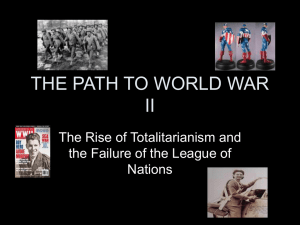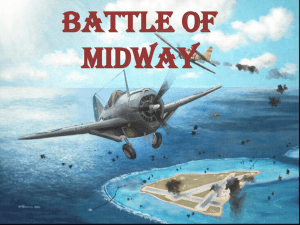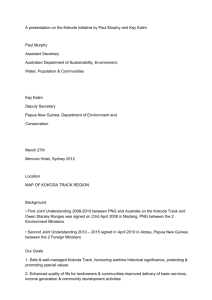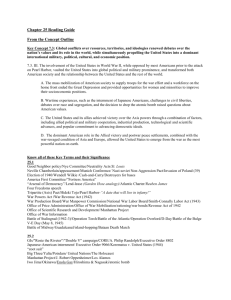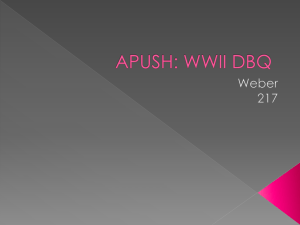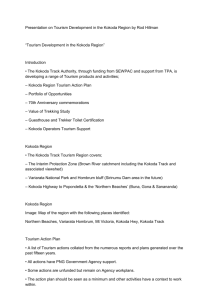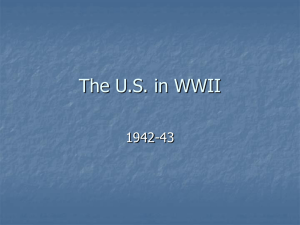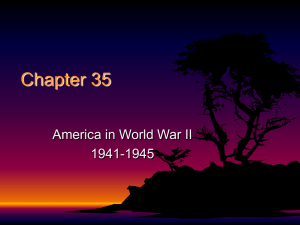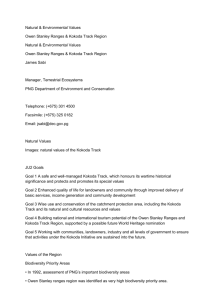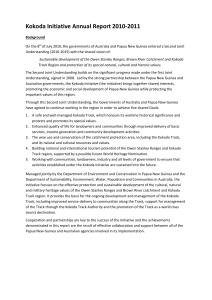Pre-TB 5 - Australian Army
advertisement
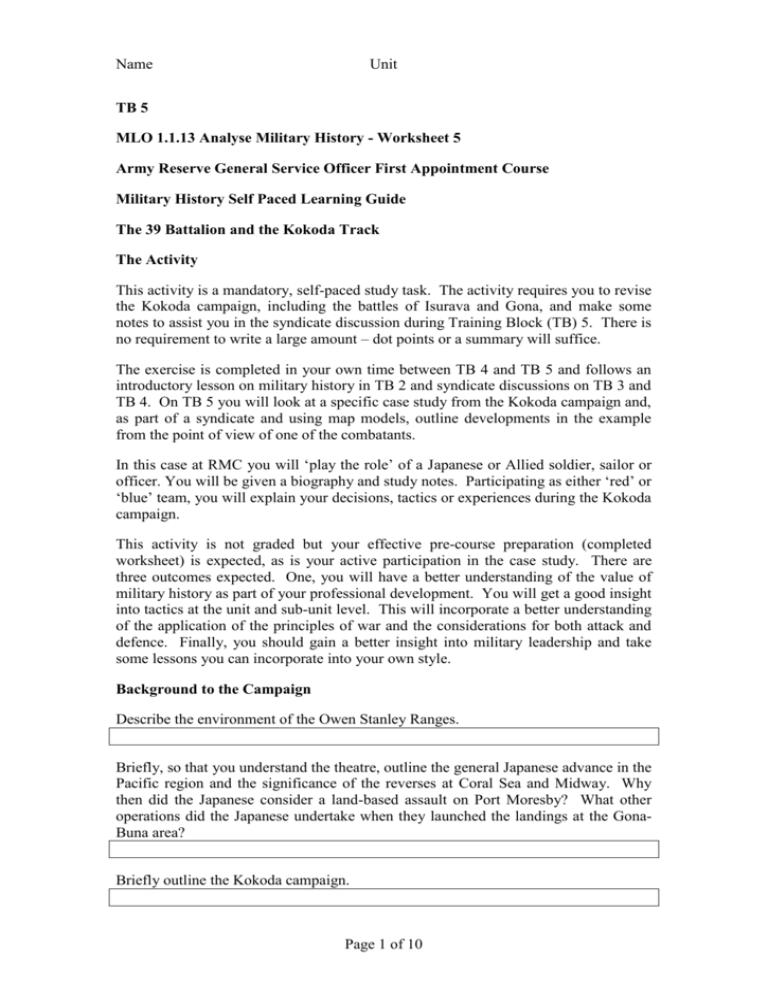
Name Unit TB 5 MLO 1.1.13 Analyse Military History - Worksheet 5 Army Reserve General Service Officer First Appointment Course Military History Self Paced Learning Guide The 39 Battalion and the Kokoda Track The Activity This activity is a mandatory, self-paced study task. The activity requires you to revise the Kokoda campaign, including the battles of Isurava and Gona, and make some notes to assist you in the syndicate discussion during Training Block (TB) 5. There is no requirement to write a large amount – dot points or a summary will suffice. The exercise is completed in your own time between TB 4 and TB 5 and follows an introductory lesson on military history in TB 2 and syndicate discussions on TB 3 and TB 4. On TB 5 you will look at a specific case study from the Kokoda campaign and, as part of a syndicate and using map models, outline developments in the example from the point of view of one of the combatants. In this case at RMC you will ‘play the role’ of a Japanese or Allied soldier, sailor or officer. You will be given a biography and study notes. Participating as either ‘red’ or ‘blue’ team, you will explain your decisions, tactics or experiences during the Kokoda campaign. This activity is not graded but your effective pre-course preparation (completed worksheet) is expected, as is your active participation in the case study. There are three outcomes expected. One, you will have a better understanding of the value of military history as part of your professional development. You will get a good insight into tactics at the unit and sub-unit level. This will incorporate a better understanding of the application of the principles of war and the considerations for both attack and defence. Finally, you should gain a better insight into military leadership and take some lessons you can incorporate into your own style. Background to the Campaign Describe the environment of the Owen Stanley Ranges. Briefly, so that you understand the theatre, outline the general Japanese advance in the Pacific region and the significance of the reverses at Coral Sea and Midway. Why then did the Japanese consider a land-based assault on Port Moresby? What other operations did the Japanese undertake when they launched the landings at the GonaBuna area? Briefly outline the Kokoda campaign. Page 1 of 10 Name Unit The 39 Battalion Outline the formation of the 39 Battalion. What actions were undertaken by the first CO, LTCOL Conran, to strengthen the unit? Describe the preparation and leadership of the 39 Infantry Battalion prior to deployment at Kokoda. Contrast the leadership approaches of the two commanders of the 39 Infantry Battalion following the death of LTCOL Owen? How might the differences of approach between MAJ Cameron and LTCOL Honner be seen against the Principles of War (especially Morale) and the Principles of Leadership? The Battle of Isurava Describe the disposition of the 39 Battalion at Isurava. How did LTCOL Honner attempt to utilise the Principles of War in his plan for the defence? What weaknesses could be identified in their utilization? Outline the Japanese plan to attack Isurava. How did MAJGEN Horii attempt to utilise the Principles of War? What weaknesses could be identified in their utilization? What was the significance of the Japanese not exploiting the failure of the 53 Battalion (like 39 Battalion of the 30 Brigade) to hold the western flank? Relate this to the Principles of War. Why did Brigadier Potts (Commander 21 Brigade) commit two of his battalions (2/14 and 2/16) company by company to Isurava? What role did his third battalion (2/27) play? The 39 Battalion was relieved by the 2/14 Battalion on 27 August 1942 and its CO, LTCOL Key took command of the battle at Isurava. Comment on the battle from this date and the role of the 39 Battalion. What role was played by the 2/16 Battalion? Relate these to the Principles of War. The Withdrawal Continues Briefly comment on the Australian withdrawal along the Kokoda Track until Imita Ridge and the Japanese response. Page 2 of 10 Name Unit Following the Battle of Ioribaiwa, the Japanese were forced to withdraw. Consider the Principles of War in the Japanese High Command’s decision. Following Isurava, briefly comment on the Australian withdrawal along the Kokoda Track until Imita Ridge and the Japanese response. What was the difference between the two withdrawals? The Australian Offensive Briefly outline the Australian offensive along the Kokoda Track and the Japanese response. The Battle of Gona Describe the Japanese defences at Gona. How had Japanese commanders utlised the Principles of War? What weaknesses could be identified in their utilization? Outline the initial Australian plan, developed by GOC 7 Div, MAJGEN Vasey, to reduce the Japanese beachhead. How did this plan utilize the Principles of War? What weaknesses could be identified in their utilization? Following the deployment of the 39 Battalion to Gona, describe the area allocated to the unit. The 39 Battalion was ordered to attack Gona on three occasions. What was the result of these three attacks? Briefly describe the attack on the 8/9 December 1942. How did this plan utilize the Principles of War? What weaknesses could be identified in their utilization? Following the reduction of Gona, what did the 39 Battalion face and what tasks were required to be undertaken? How did the campaign end? Logistics Explain the importance of resupply to both the Australians and Japanese during the Kokoda campaign. How did each seek to maintain and sustain their combat force? Comment on the impact of this on the tactical planning by the respective Page 3 of 10 Name Unit commanders. What efforts were made to interdict the logistic chain of the opposing force? Summary Consider the two battles of Isurava and Gona and the Principles of War. Complete the following tables by briefly commenting on the application of the Principles of War and Leadership by both Japanese and Australian commanders. Generally, you should look to a positive application, however, where these were ignored, you should also comment. Page 4 of 10 Name Principle of War Unit Isurava Gona Selection and Maintenance of the Aim Concentration of Force Co-operation Economy of Effort Security Offensive Action Surprise Flexibility Sustainment Morale Table 1. Principles of War Page 5 of 10 Name Unit Leadership Australian Japanese Be proficient Know yourself and seek self-improvement Seek and accept responsibility Lead by example Provide direction Know and care for your subordinates Develop the potential of your subordinates Make sound and timely decisions Build the team and challenge its abilities Keep your team informed Table 2. Principles of Leadership Page 6 of 10 Name Unit Cadets must not engage in academic misconduct. Academic misconduct is acting in a way, or attempting to act in a way, or assisting another cadet to act in a way which could reasonably be expected to defeat the purpose of a learning experience or an item of assessment or an examination. Plagiarism, cheating or collusion is evidence of academic misconduct and is a significant integrity breach. A breach of the above may result in the recommendation for termination of the offending cadet’s probationary appointment as an officer THE WORKSHEETS ARE TO BE THE PRODUCT OF YOUR OWN WORK. YOU ARE NOT TO COLLUDE WITH OR COPY THE WORK OF ANOTHER CADET WHEN COMPLETING THE WORKSHEETS. IF YOU ARE FOUND TO HAVE COPIED OR COLLUDED YOU WILL BE SUBJECT TO DISCIPLINARY ACTION WHICH MAY RESULT IN A CHARGE AND SUBSEQUENT REMOVAL FROM THE COURSE. Annexes A. Suggested Reading List B. Kokoda Campaign Timeline Page 7 of 10 Name Unit ANNEX A SUGGESTED REFERENCES Web based resources http://www.awm.gov.au/cms_images/awm52/8/AWM52-8-3-78-004.pdf (The war diary of the 39 Infantry Battalion) http://www.awm.gov.au/histories/chapter.asp?volume=21 (The official Australian history of WW II – the first year of operations in the SW Pacific) http://niusleta.kokodatreks.com/documents/RalphHonnerOrationbyPatrickLindsay20 Aug30.doc (Address on the leadership qualities of Ralph Honner, DSO, MC and the Kokoda campaign) http://www.gg.gov.au/spdf/2005/s2005072320.pdf (A speech by the former Governor General, MAJGEN Michael Jeffery, AC, CVO, MC on Kokoda) http://www.kokodatreks.com/history/thekokodacampaign.cfm (A commercial Kokoda Track operator) Book resources Austin, V., To Kokoda and Beyond: The Story of the 39th Battalion Melbourne, Melbourne University Press, 1988 Barrett, J., We were there: Australian soldiers of World War II tell their stories Sydney, Allen & Unwin, 1995 Beaumont, J., Australia's war, 1939-1945 Sydney, Allen & Unwin, 1996 Browne, M. and Selhofer, H., The Kokoda Campaign Melbourne, Hachette Livre Australia, 1985 Brune, P., A Bastard of a Place Sydney, Allen & Unwin, 2003 Brune, P, Gona's Gone Sydney, Allen & Unwin (in Association with TC-A) 2000 Brune, P., Ralph Honner: Kokoda Hero Sydney Allen & Unwin, 2007 Brune, P., Those Ragged Bloody Heroes Sydney, Allen & Unwin, 1991 Edgar, W., Warrior of Kokoda: A Biography of Brigadier Arnold Potts Sydney, Allen & Unwin, 1999 FitzSimons, P., Kokoda Melbourne, Hachette Livre, 2004 Hall, T., New Guinea 1942 -44 Sydney, Methuen, 1981 Hawthorne, S., The Kokoda Trail: A History Brisbane, Central Queensland University Press & Old Silvertail's Outback Books, 2003 Ham, P., Kokoda Sydney, HarperCollins, 2004 James, W., Field Guide to the Kokoda Track: An Historical Guide to the Lost Battlefields Sydney, Kokoda Press, 2006 Johnson, C., (ed) Mud Over Blood: Stories from the 39th Infantry Battalion 1941-43, Kokoda to Gona Melbourne, History House, 2005 Lindsay, P., The Spirit of Kokoda: Then and Now Melbourne, Hardie Grant Books, 2002 McAulay, L., Blood and Iron: The Battle for Kokoda 1942 Sydney, Hutchinson, 1991 McDonald, N., and Brune, P., 200 Shots: Damien Parer and George Silk with the Australians at War in New Guinea Sydney, Allen & Unwin, 2005 Paul, R., Retreat From Kokoda Melbourne, Heinemann, 1958 Sublet, F., Kokoda to the Sea: A History of the 1942 Campaign in Papua Melbourne, Slouch Hat Productions, 2000 Page 8 of 10 Name Unit ANNEX B KOKODA CAMPAIGN TIME LINE Date Event 21 July 1942 The Japanese expeditionary force lands at their beachhead in the Gona-Sanananda-Buna area – commanded by MAJGEN Horii 23 July 1942 First contact between the Japanese and Australian forces at Awala – elements of the Papuan Infantry Battalion 26 July 10942 Australians fight company delaying action at Oivi – CAPT Templeton, OC B Coy 39 Battalion KIA 28-29 July 1942 First Battle of Kokoda – Japanese capture the village and prepare for advance to Port Moresby and also reinforce the beachhead as this axis of advance offers best chance to capture the capital of PNG 28 July 1942 LTCOL Owen, CO 39 Battalion KIA at Battle of Kokoda 4 August 1942 MAJ Cameron assumes command of 39 Battalion – at Deniki 8-10 August 1942 Second Battle of Kokoda results in Australians recapturing the village. However, it can not be held against vastly superior forces and the withdrawal of Australians down the Kokoda Track begins 13-14 August 1942 Battle of Deniki 16 August 1942 LTCOL Ralph Honner, MC assumes command of 39 Battalion – at Isurava 26-30 August 1942 Battle of Isurava 30 August 1942 Australians continue to withdraw down the Kokoda Track 2 September 1942 Australians withdraw to Eora Creek 3 September 1942 Australians withdraw to Templeton’s Crossing 4 September 1942 Australians withdraw to Myola 6 September 1942 39 Battalion parade at Menari 8 September 1942 Battle of Brigade Hill (Mission Ridge) 10 September 1942 Australians withdraw to Menari 11-16 September 1942 Battle of Ioribaiwa Page 9 of 10 Name Unit 16 September 1942 Australians withdraw to Imita Ridge – the last position occupied during the withdrawal 24 September 1942 Japanese withdraw from Ioribaiwa 28 September 1942 Australian advance across the Kokoda Track commences 11 October 1942 Japanese delay Australian advance at Mount Bellamy 12-17 October 1942 Battle of Templeton’s Crossing 21-29 October 1942 Battle of Eora Creek 2 November 1942 Australian advance reaches Kokoda and the village is re-occupied without resistance from the Japanese, that continue to withdraw to their beachhead 5-11 November 1942 Battle of Oivi-Gorari 9 November 1942 21 Brigade parade at Koitaki plantation 15 November 1942 Battle of the Sanananda Track begins 18 November 1942 Battle of Gona begins 19 November 1942 Battle of Buna begins 9 December 1942 Gona captured by 39 Battalion and LTCOL Ralph Honner, MC sends his famous message “Gona’s Gone”. 2 January 1943 Buna captured 21 January 1943 Organised Japanese resistance at Sanananda ceases – isolated pockets continue Page 10 of 10

